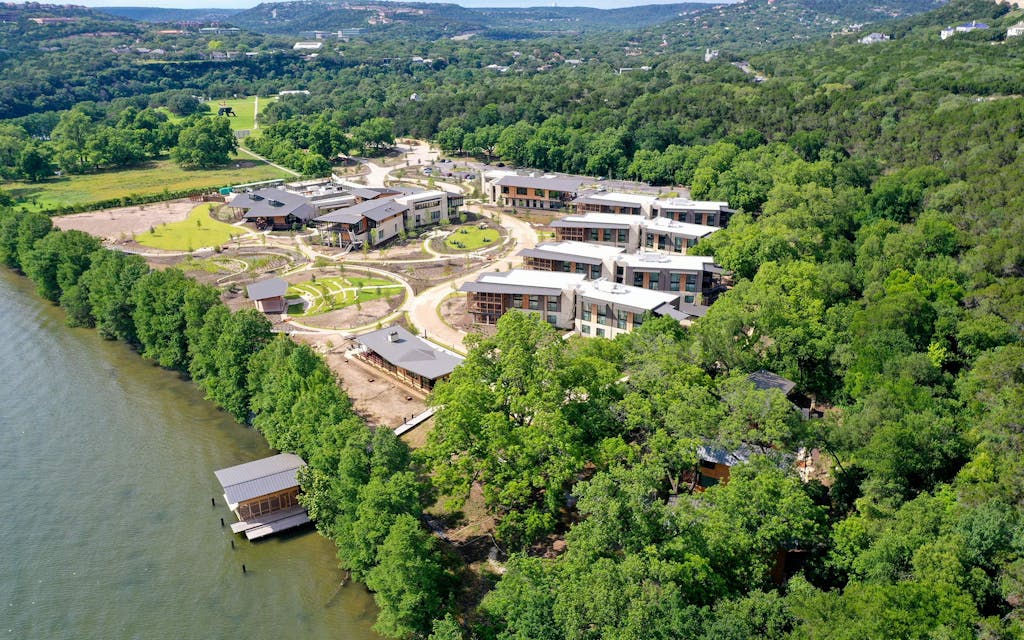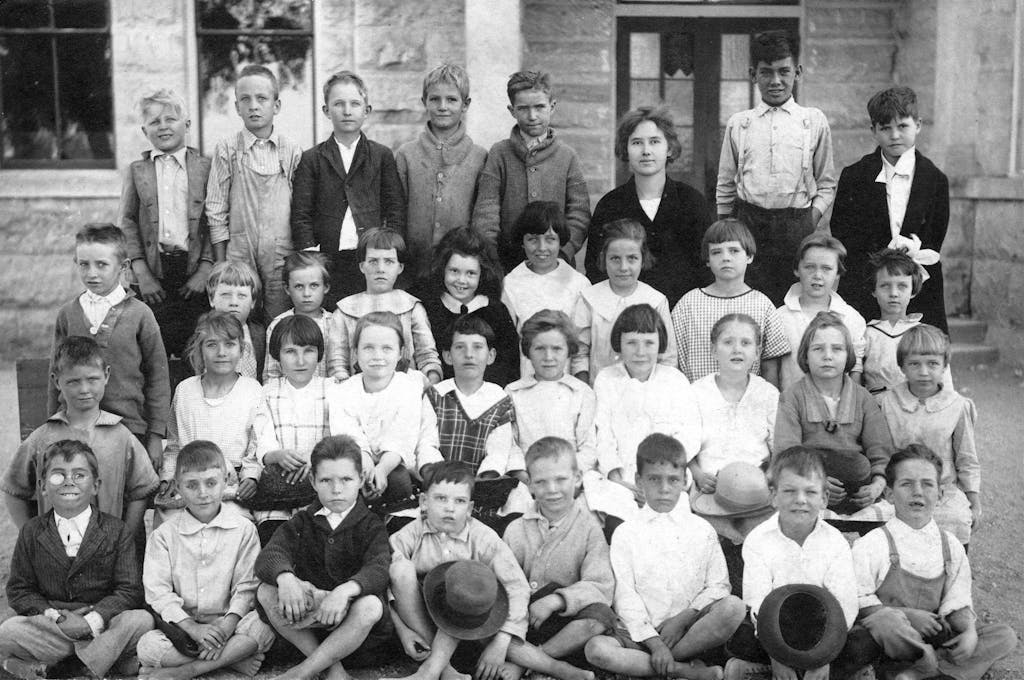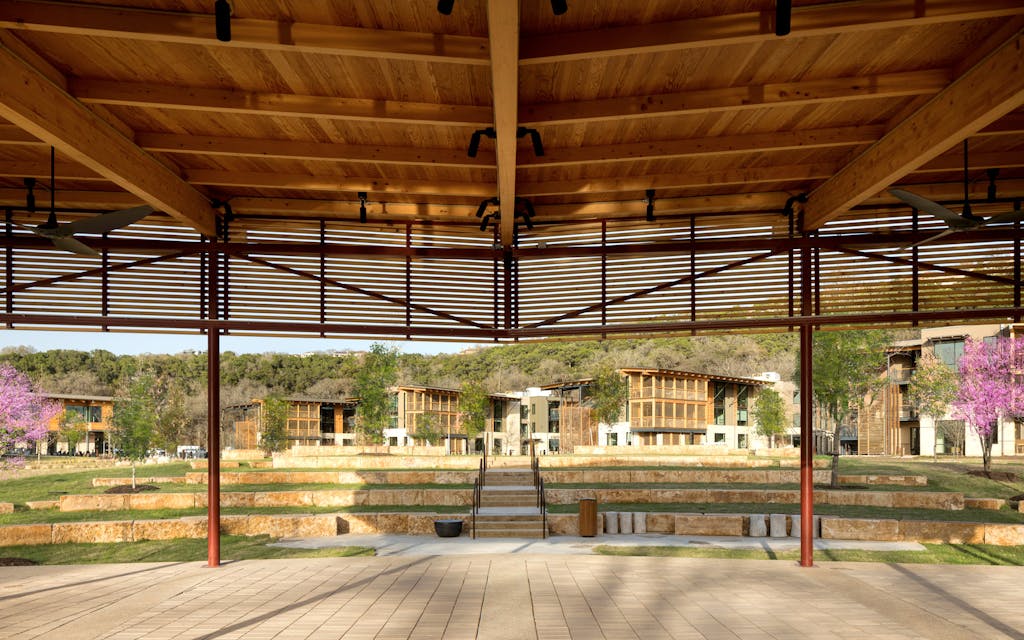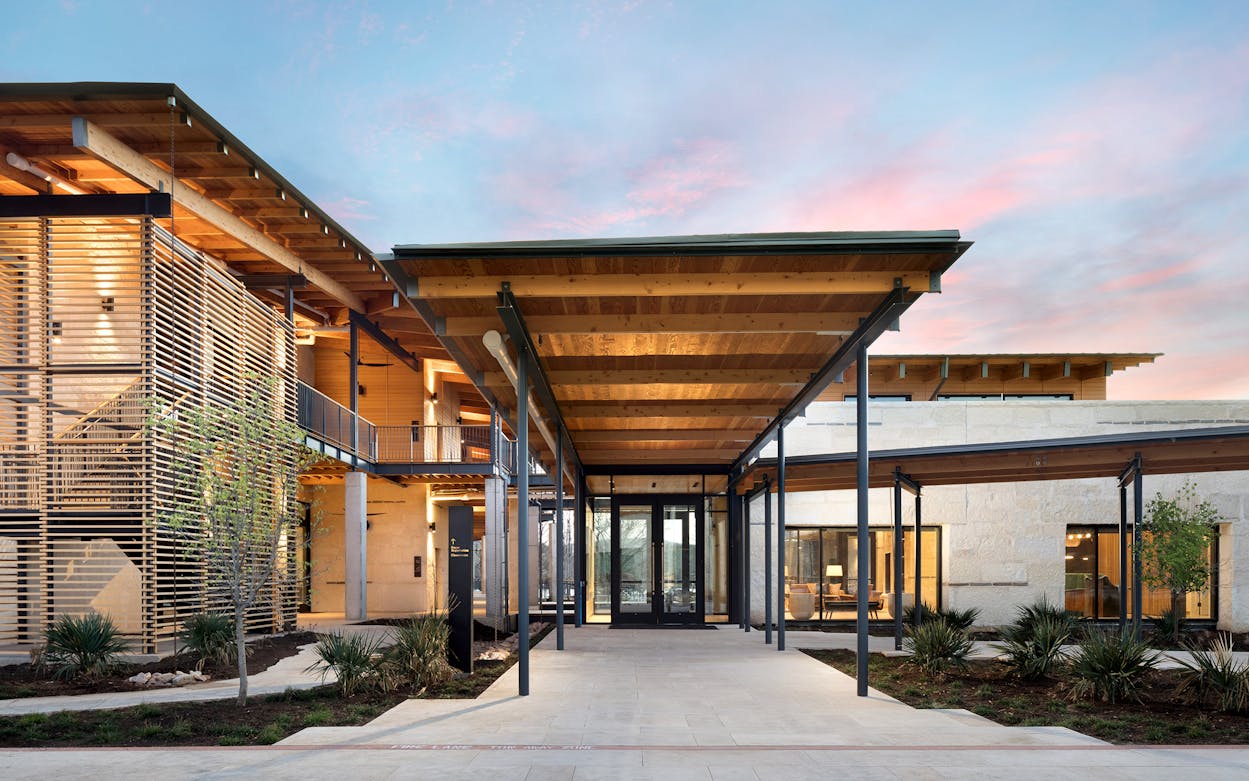Most of the public educators who catch their first glimpse of the Holdsworth Center, the new $200 million complex where they can “learn, reflect, and grow,” have the same reaction. After clearing the guardhouse and curving down a road that slopes seductively toward Lake Austin, they cannot believe their eyes.
What appears before them is a stunning campus endowed by H-E-B chairman Charles Butt, designed by the San Antonio–based firm Lake Flato, and landscaped by Austin’s Ten Eyck team. Limestone buildings, featuring myriad coffee bars and artwork by the likes of Alex Katz and Ellsworth Kelly, are accentuated with rich, sorrel-hued wood trim. Dormitories have been outfitted with screened porches. Native plants bloom in swirling patterns along meditative pathways. A cozy, après-ski-like bar encourages impromptu breakout sessions, and a two-story boathouse extends over the water with a view of the Austin Country Club. In other words, Holdsworth resembles a retreat designed for the comfort of the most exclusive one-percenters.

Hence the pinch-me-again reaction of a small, beleaguered group of superintendents and other educators who had been selected for Holdsworth’s leadership training course, and who would normally never see, much less stay at, such a luxurious retreat in their lives. Thomas Randle, the former superintendent of Lamar Consolidated Independent School District, southwest of Houston, was awestruck by his first glimpse of the campus. “This is for educators,” he thought, his astonishment infused with pride. Rodney E. Watson, the superintendent of Spring ISD, north of Houston, was dazed to learn that someone “would think highly enough of public school leaders” to create such a sumptuous oasis just for them. Jeanette Ball, superintendent of Judson ISD, northeast of San Antonio, said the campus “renewed me with hope.”
Hope was, in fact, the dominant emotion at last week’s graduation ceremony for the second class of Holdsworth’s two-year leadership training program for public school district leaders. That program is only the first part of multiple five-year partnerships Holdsworth aims to form with selected school districts. During the span of five years, cohorts of principals and their teams from each district will take their own two-year learning programs.
The first two graduating classes gathered for training and retreats across the state; future ones will get to enjoy the center regularly, not just for graduations. With the 44-acre campus’s official opening scheduled for Wednesday, July 23, the center and its program represent one of the biggest gambles in public education to date: the bet that providing educators with many of the same tools accessible to corporate executives can transform the lives of Texas schoolchildren, preparing them to best meet the technical, economic, and social challenges of the state’s future.
The honorees on the day I visited were school superintendents and the groups of six team members each had selected from among other administrators in their districts. They had driven in from towns including Harlingen and Mesquite, and they were thrilled they didn’t have to double up in hotel rooms, usually de rigueur for education confabs. They represented all kinds of Texans, and they clapped and rang cowbells as each team lined up to receive medals draped around their necks and pose, beaming, for photos.
“You look like you went to the Olympics,” a Holdsworth staffer said to a participant who was clasping her medal close to her heart.
“The Smart Olympics,” she corrected.

One can only assume those words would be no small comfort to Charles Butt, who has spent much of his life trying to figure out how to improve Texas’s more than 1,200 public school districts and charters and, in turn, the education of Texas’s 5.5 million public school students. As he wrote me in an email, “Wise Ben Franklin considered [public education] essential. Some see it as an expense. I see it as vital. Education is the basis of our country’s progress. It’s our best defense against chaos and decline.”
In that spirit, Butt created Raise Your Hand Texas in 2006, an advocacy nonprofit designed to “reinvent public education for the 21st century.” The organization has the thankless, if crucial, task of monitoring and muscling the Legislature, which often seem more inclined to dismantle public schools than support them. Despite the state’s receiving some huzzahs for keeping schools functioning during the pandemic, the quality of Texas public school education still ranks a mediocre thirty-fourth in the nation, according to U.S. News & World Report. An educated workforce may be the key to Texas’s future, but it’s frequently overlooked in Austin amid debates about the alleged threat posed by trans kids and over what elements of the state’s history that teachers will be forbidden to teach.
Butt created the Holdsworth Center in 2017 to open another front in the battle to better public education here. Overall, its mission is to train and retrain leaders: superintendents apply with a team of coworkers for a five-year program that will allow them to rethink their assumptions and challenge the status quo—as Fortune 500 CEOs are encouraged to do. Considering the structure of the program, it’s not at all surprising that Butt completed some executive programs at Harvard. So far, the program serves nineteen of the state’s school districts and 957 campuses. Scalability is the goal.

The project is also a perfect reflection of Butt’s attitude toward giving: generous, rigorous, and low-profile (his name appears at only a single location on campus, near the exit). “One of the things that is typically Charles is that, with all he knows, he sits up at night, thinking he hasn’t done enough, and figures out how to do more,” Holdsworth’s president, Lindsay Whorton, told me. When you are a successful company builder and billionaire, that means you can convene a group of advisers who are inordinately successful themselves. In Butt’s case, in 2015 he corralled General George Casey, who led U.S. troops in Iraq; Mike Johnston, a Colorado state senator who was a senior education-policy adviser to Barack Obama during his 2008 presidential campaign; and Jon Schnur, an adviser to former U.S. education secretary Arne Duncan and New York mayor Michael Bloomberg.
Notable Texans signed on as well, including Shari Becker Albright, an award-winning elementary school principal and administrator with a doctorate in education from Teachers College, Columbia University; Dallas attorney Tom Luce, who was Ross Perot’s consigliere and George W. Bush’s assistant secretary of education, and who now runs the future-oriented Texas 2036 Foundation; and Ann Stern, who heads the philanthropic Houston Endowment.
Butt also wooed Whorton away from the Boston Consulting Group, in Washington, D.C. She is a Rhodes and Fulbright scholar with a doctorate in social policy from Oxford University. Her 2016 book, Teachers’ Unions and Education Reform in Comparative Contexts, grew out of her research at the University of Helsinki, which has one of the world’s best teacher-education programs.
The group spent a year researching and traveling the world to decide how Butt could best improve public education in Texas. They visited the National College for Teaching and Leadership, in Nottingham, England; then they went to Singapore, which, according to Whorton, “has a very strategic play for developing educators and leaders.” They also investigated corporate leadership at companies such as Southwest Airlines, Procter & Gamble, and, not surprisingly, H-E-B, scouring for best practices. And they went to the Army War College, in Pennsylvania, and Fort Leavenworth, in Kansas, to look at military training programs. By 2016 they had a blueprint for a curriculum. All agreed the focus would be on leadership—developing systems and structures to grow and perpetuate the talent already gestating inside Texas schools.

Charles Butt does not skimp on talent. One leader may have been the most important influencer, however: Butt’s mother, Mary Elizabeth Holdsworth, a pert dynamo who often said, “One solitary life can make a difference,” and spent her days proving that maxim. Holdsworth, who was born in South Texas in 1903, was a teacher in Center Point and later in Kerrville, while her husband, Howard E. Butt, ran the family grocery store. When the family moved to the Rio Grande Valley during the Depression, Holdsworth was overwhelmed by the poverty of the region. She began promoting social justice causes almost from the day she arrived, an effort that intensified when the couple, with three children, moved to Corpus Christi. (Charles is the youngest; a fourth child, Mary Beth, was stillborn.)
An early working mom and multitasker, Holdsworth was a one-woman volunteer dervish, lobbying to improve the juvenile justice system, caring for those with tuberculosis in the days before antibiotics, and creating a home for the aged and a day-care center for Black children, a radical act at the time. Appointed to the state’s governing board for mental hospitals in 1955, she was appalled by the treatment of Texas patients. There were few psychoactive drugs then, patients lived in squalor, and one hospital with a population of 1,400 had exactly one psychiatrist. Holdsworth spent the next 26 years advocating for the better treatment of mentally ill and disabled patients. She died in 1993.
As tiny as she was, Holdsworth was never afraid to speak truth to power in Austin. As one state official noted of working with her, “Set upon an objective . . . [she] pursues it with the doggedness that would disgrace a Marine sergeant.” It may be her determination, most of all, that informed son Charles’s character and inspired the creation of the center bearing his mother’s name.

By January 2017, the group Butt had assembled had a curriculum plan, along with a $100 million gift from Butt to fund the first five to seven years. As the organization moved closer to its launch phase, he donated another $200 million. There were two pilot programs, one at Klein ISD, just north of Houston, and another in Grand Prairie, west of Dallas, but the question of whether the training will work is still an open one.
The curriculum includes three core areas. First is personal leadership—how educators manage themselves and their schools’ resources, and their ability to identify their own strengths and weaknesses, along with their ability to change. As Whorton put it, Holdsworth aims to “cultivate in adults the idea that they can keep evolving and growing.” The second goal is to convert that self-knowledge into an ability to empower others to coach, mentor, and encourage teams of subordinates—spreading the emotional health and wealth, in a sense. The third aim is to effect substantive change. “We heard a lot of those themes when we talked to principals and superintendents,” Whorton told me. Holdsworth’s goal “is to figure out where they are struggling and where there are gaps.”
The program involves a great deal of off-campus required reading, followed by what will now be on-campus problem-solving discussions centered on specifics, such as rethinking teaching strategies and promoting student engagement. Whorton compares the curriculum to an abbreviated executive MBA program, with about thirty days of in-person learning spread out over two years. On campus, there are lectures by leading educators and experts in the field of leadership and management. As one of the graduates noted, Holdsworth “doesn’t just bring in someone who read the book; they brought the person who wrote the book.” No one leaves without an action plan.

So far, success can be measured only by the few teams who have been through the program. Talks with several school superintendents suggested that they had gained insights into themselves that had led them to manage others more generously and more productively, resulting in higher teacher retention and more open discussion of problems. “I actually see people treating each other well,” Judson superintendent Jeanette Ball said. “I see people working well together for the students.”
If nothing more, the gratitude and inspiration evinced by Holdsworth participants are an early sign of success. As Ball put it, the Holdsworth Center’s very existence shows that “somebody really values public school and public education.”
- More About:
- Austin








